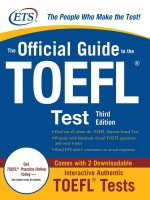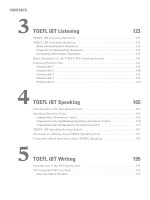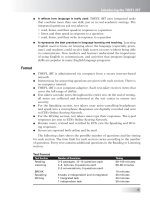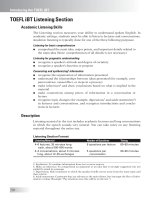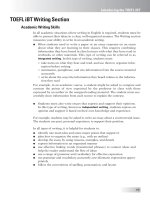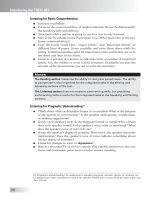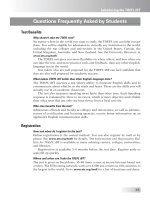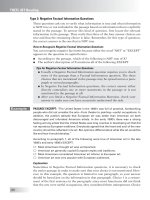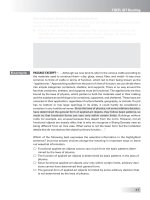The official guide to the toefl ibt third edition part 4 ppt
Bạn đang xem bản rút gọn của tài liệu. Xem và tải ngay bản đầy đủ của tài liệu tại đây (292.28 KB, 7 trang )
Introducing the TOEFL iBT
TOEFL iBT Listening Section
Academic Listening Skills
The Listening section measures your ability to understand spoken English. In
academic settings, students must be able to listen to lectures and conversations.
Academic listening is typically done for one of the three following purposes:
Listening for basic comprehension
b
comprehend the main idea, major points, and important details related to
the main idea (Note: comprehension of all details is not necessary.)
Listening for pragmatic understanding
b
recognize a speaker’s attitude and degree of certainty
b
recognize a speaker’s function or purpose
Connecting and synthesizing
5
information
b
recognize the organization of information presented
b
understand the relationships between ideas presented (for example, com-
pare/contrast, cause/effect, or steps in a process)
b
make inferences
6
and draw conclusions based on what is implied in the
material
b
make connections among pieces of information in a conversation or
lecture
b
recognize topic changes (for example, digressions
7
and aside statements
8
)
in lectures and conversations, and recognize introductions and conclu-
sions in lectures
Description
Listening material in the test includes academic lectures and long conversations
in which the speech sounds very natural. You can take notes on any listening
material throughout the entire test.
Listening Section Format
Listening Material Number of Questions Timing
4–6 lectures, 35 minutes long 6 questions per lecture 60–90 minutes
each, about 500–800 words
2–3 conversations, about 3 minutes 5 questions per 60–90 minutes
long, about 12–25 exchanges conversation
12
5. Synthesize: To combine information from two or more sources
6. Make an inference: To comprehend an argument or an idea that is strongly suggested, but not
explicitly stated in a passage
7. Digressions: Side comments in which the speaker briefly moves away from the main topic and
then returns
8. Aside statements: Comments that are relevant to the main theme, but interrupt the flow of infor-
mation or ideas (Example: “Pay attention now, this will be on the test.”)
Academic Lectures
The lectures in the TOEFL iBT reflect the kind of listening and speaking that
occurs in the classroom. In some of the lectures, the professor does all or almost
all of the talking, with an occasional comment by a student. In other lectures, the
professor may engage the students in discussion by asking questions that are
answered by the students. The pictures that accompany the lecture help you
know whether one or several people will be speaking.
13
Introducing the TOEFL iBT
A Lecture Where the Professor Is the Only Speaker
A Lecture Where the Professor and the Students Both Speak
Introducing the TOEFL iBT
Conversations in an Academic Setting
The conversations on the TOEFL iBT may take place during an office meeting
with a professor or teaching assistant, or during a service encounter with univer-
sity staff. The contents of the office conversations are generally academic in
nature or related to course requirements. Service encounters could involve
conversations about a housing payment, registering for a class, or requesting
information at the library.
Pictures on the computer screen help you imagine the setting and the roles of the
speakers.
14
Conversation Example
Listening Question Formats
After the listening material is played, you both see and hear each ques-
tion before you see the answer choices. This encourages you to listen
for main ideas.
There are four question formats in the Listening section:
b
traditional multiple-choice questions with four answer choices
and a single correct answer
b
multiple-choice questions with more than one answer (e.g., two
answers out of four or more choices)
b
questions that require you to order events or steps in a process
b
questions that require you to match objects or text to categories
in a chart
15
Introducing the TOEFL iBT
Chart Question Example
Features
b
Note taking is allowed. After testing, notes are collected and destroyed
before you leave the test center for test security purposes.
b
A multiple-choice question measures understanding of a speaker’s atti-
tude, degree of certainty, or purpose. These questions require you to listen
for voice tones and other cues and determine how speakers feel about the
topic they are discussing.
b
In some questions, a portion of the lecture or conversation is replayed so
you do not need to rely on memory of what was said.
In the replay format, you listen to part of the conversation or lecture again
and then answer a question. Sometimes the question repeats a portion of the
listening material again, as indicated by the headphones icon in the example on
page 16.
Introducing the TOEFL iBT
This is an example of a type of question that measures the comprehension of a
speaker’s purpose.
16
TOEFL iBT Speaking Section
Academic Speaking Skills
Students should be able to speak successfully in and outside the classroom. The
Speaking section measures your ability to speak effectively in academic settings.
In classrooms, students must:
b
respond to questions
b
participate in academic discussions with other students
b
synthesize
9
and summarize what they have read in their textbooks and
heard in class
b
express their views on topics under discussion
Outside of the classroom, students must:
b
participate in casual conversations
b
express their opinions
b
communicate with people in such places as the bookstore, the library, and
the housing office
Description
The Speaking section is approximately 20
minutes long and includes six tasks.
b
The first two tasks are independent
speaking tasks
on topics familiar to you.
They ask you to draw upon your own
ideas, opinions, and experiences when
responding. (However, you can respond
with any idea, opinion, or experience
relevant to completing the task.)
b
The remaining four tasks are integrated
tasks
where you must use more than one
skill when responding. First read and lis-
ten, and then speak in response. You can
take notes and use those notes when responding to the speaking tasks. At
least one requires you to relate the information from the reading and the
listening material.
Like all the other sections of the TOEFL iBT, the Speaking section is delivered
via computer. For all speaking tasks, you use a headset with a microphone. Speak
into the microphone to record your responses. Responses are digitally recorded
and sent to ETS’s Online Scoring Network where they are scored by certified
raters.
17
Introducing the TOEFL iBT
9 Synthesize: To combine information from two or more sources
Introducing the TOEFL iBT
18
Speaking Task Types
Task Type Task Description Timing
Independent Tasks
1. Personal Preference This question asks the test taker to express and Preparation time: 15 seconds
defend a personal choice from a given category— Response time: 45 seconds
for example, important people, places, events, or
activities that the test taker enjoys.
2. Choice This question asks the test taker to make and Preparation time: 15 seconds
defend a personal choice between two Response time: 45 seconds
contrasting behaviors or courses of action.
Integrated Tasks
Read/Listen/Speak
3. Campus Situation • A reading passage (75–100 words) presents a Preparation time: 30 seconds
Topic: Fit and Explain campus-related issue. Response time: 60 seconds
• A listening passage (60–80 seconds, 150–180
words) comments on the issue in the reading
passage.
• The question asks the test taker to summarize
the speaker’s opinion within the context of the
reading passage.
4. Academic Course • A reading passage (75–100 words) broadly Preparation time: 30 seconds
Topic: General/ defines a term, process, or idea from an Response time: 60 seconds
Specific academic subject.
• An excerpt from a lecture (60–90 seconds;
150–220 words) provides examples and specific
information to illustrate the term, process, or
idea from the reading passage.
• The question asks the test taker to combine and
convey important information from the reading
passage and the lecture excerpt.
Listen/Speak
5. Campus Situation • The listening passage (60–90 seconds; 180–220 Preparation time: 20 seconds
Topic: Problem/ words) is a conversation about a student- Response time: 60 seconds
Solution related problem and two possible solutions.
• The question asks the test taker to demonstrate
an understanding of the problem and to express
an opinion about solving the problem.
6. Academic Course • The listening passage is an excerpt from a Preparation time: 20 seconds
Topic: Summary lecture (90–120 seconds; 230–280 words) that Response time: 60 seconds
explains a term or concept and gives concrete
examples to illustrate that term or concept.
• The question asks the test taker to summarize
the lecture and demonstrate an understanding
of the relationship between the examples and
the overall topic.
TOTAL 20 minutes

